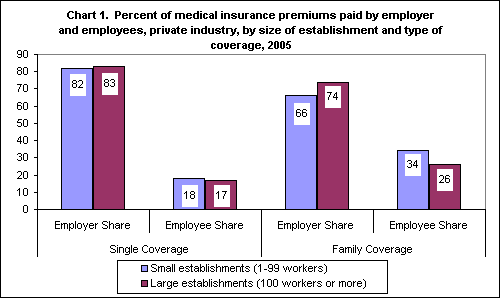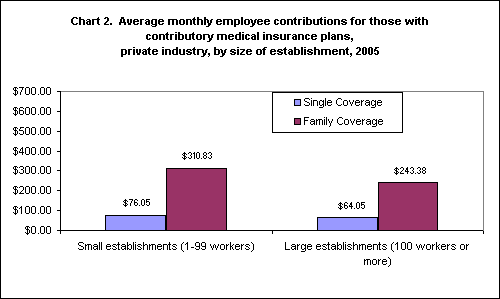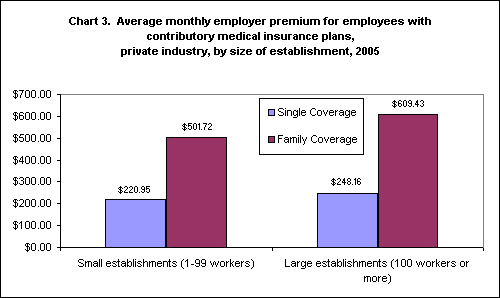| |
Printer-friendly version (HTML) |
Medical Insurance Premiums and Establishment Size, 2005
by Tiffany M. Brown
Originally Posted: August 31, 2005
According to the 2005 National Compensation Survey (NCS) benefits data, 76 percent of all private industry employees with single coverage medical insurance plans are required to contribute toward their premiums; 88 percent of those with family coverage plans are required to contribute. Among these workers in contributory plans, 75 percent pay a monthly flat rate for single coverage, and 76 percent pay a monthly flat rate for family coverage. The charts that follow show some of the details of monthly flat rate contributory plans.

- For single coverage plans, the employee share was similar for large and small establishments, 17 and 18 percent, respectively. (See chart 1.)
- For family coverage plans, employees in small establishments contribute a higher share of the cost of medical care premiums (34 percent) than do those in large establishments (26 percent).


- For both large and small establishments, the average monthly employee contribution for family coverage is more than three times the average contribution for single coverage. (See chart 2.)
- The average monthly employee contribution was lower in large establishments than in small ones for both single and family coverage. At the same time, the amount paid by employers was greater in large establishments than in small ones for both single and family coverage. (See chart 3.)
NOTE: Calculation of the average employee contribution does not include plans in which the employer pays the full premium. Also, standard errors have not been calculated for NCS benefits estimates. Consequently, none of the statistical inferences made in this report could be verified by a statistical test.
SOURCE: These data are from "National Compensation Survey: Employee Benefits in Private Industry in the United States, March 2005," Summary 05-01 (Bureau of Labor Statistics, August 2005); available on the Internet at http://www.bls.gov/ncs/ebs/sp/ebsm0003.pdf.
Tiffany M. Brown
Student Intern who worked in the Division of Data Analysis and Planning, Office of Compensation and Working Conditions, Bureau of Labor Statistics.
|